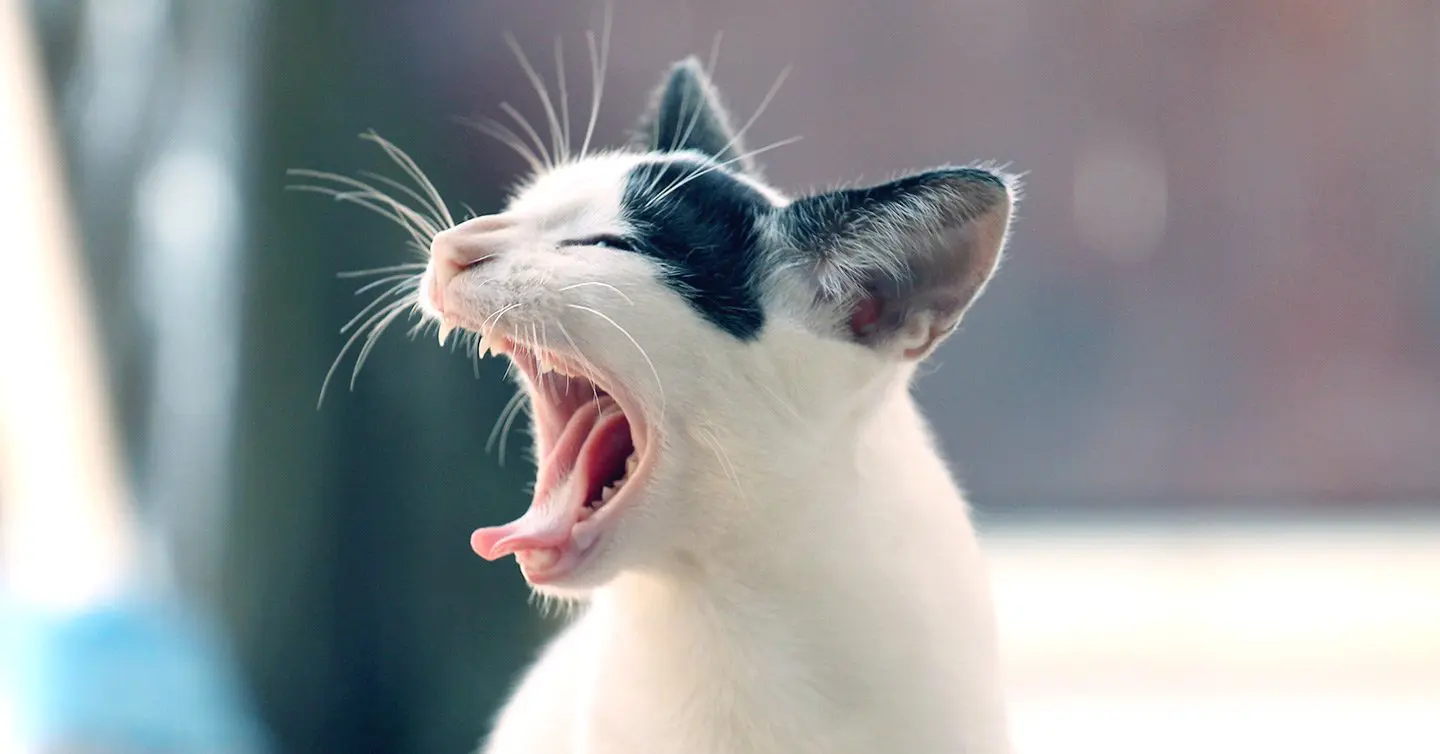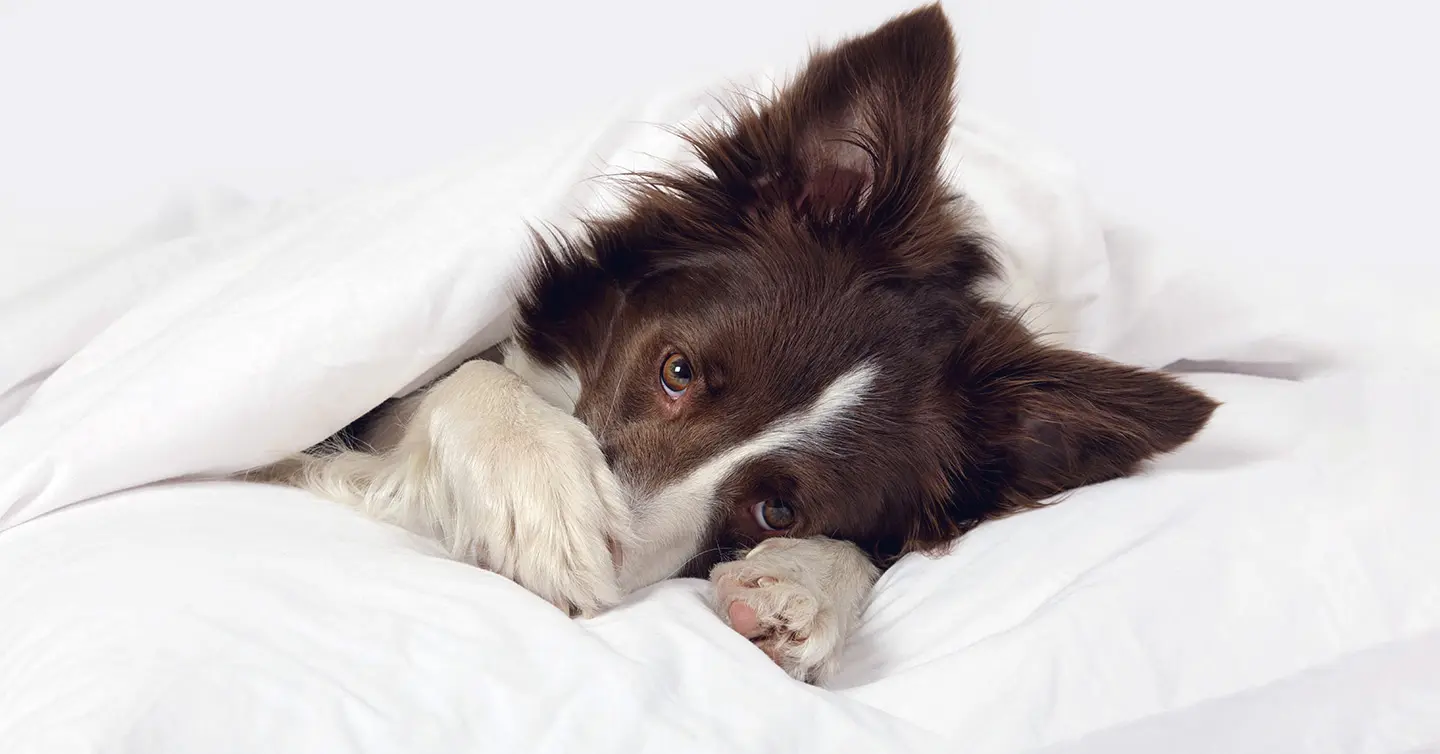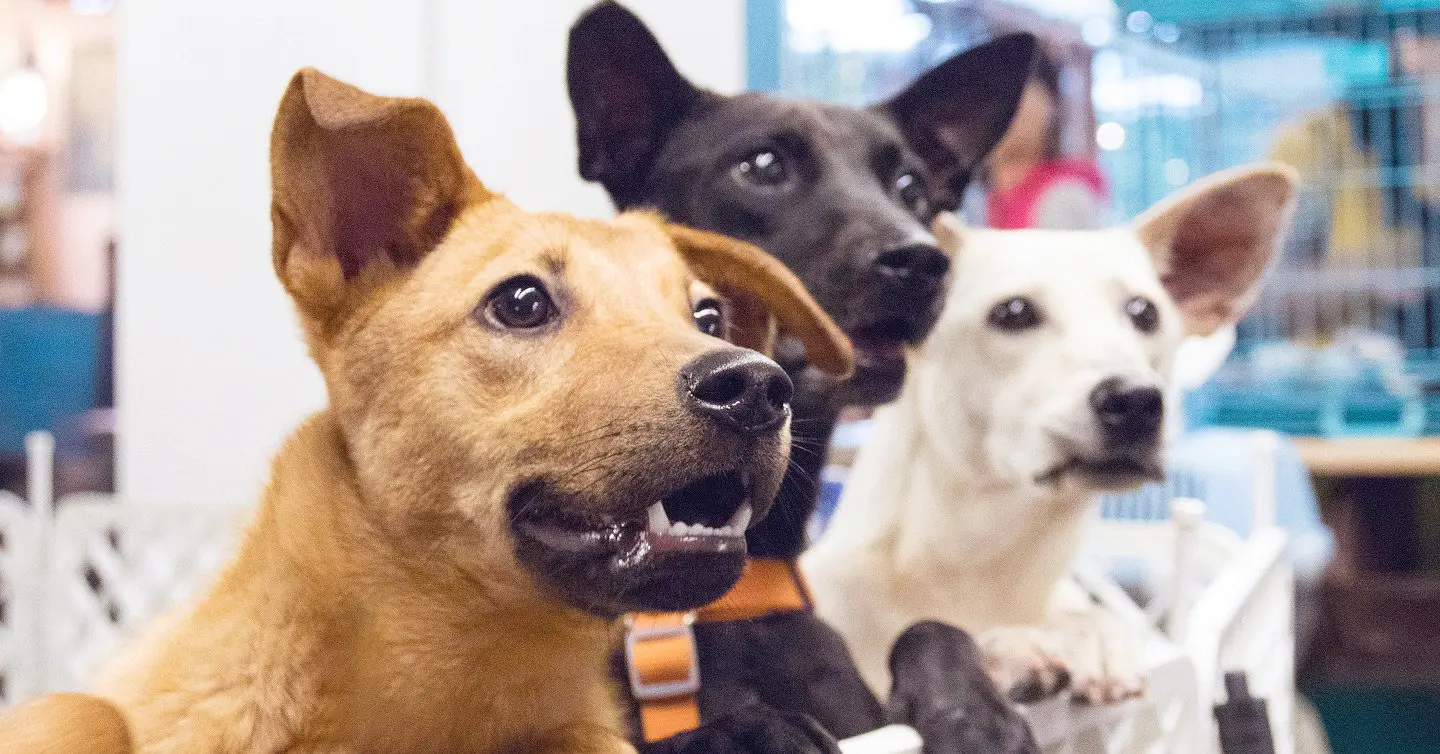Key Points
- Sneezing is a normal behavior in cats and a common symptom of upper respiratory infections (URI), the feline equivalent of the common cold.
- Excessive sneezing in cats may also be caused by allergies, parasites, fungal infections, or inflammation.
- If your cat won’t stop sneezing and has other symptoms like lethargy, hiding, nasal or eye discharge, loss of appetite, or difficulty breathing, visit your vet right away.
Cat sneezing is perfectly normal behavior. That’s right — cats get the sniffles sometimes, too.
However, if your cat is sneezing a lot, then you may need to do more than say, “Bless you.” As a loving pet owner, it can be hard to tell whether your cat has allergies, a cold, or they’re just a little too excited about their new catnip toy.
The occasional cat sneeze can actually be quite cute, but there’s nothing cute about a sick kitty. To help you spot the difference between an everyday sneeze and a more serious upper respiratory infection (URI), we’ve put together this comprehensive guide to cat sneezing. As a general rule, if your cat is sneezing more than usual or shows other worrisome symptoms, it’s never a bad idea to call your vet for advice.
The causes of sneezing in cats
There could be several reasons why your cat is sneezing, and most aren’t a cause for alarm. So, what’s the first step in getting to the bottom of it? First, you need to figure out whether their sneezing fits are acute or chronic.
Acute cat sneezing
In medical terms, acute refers to a phenomenon that occurs suddenly, usually in response to a specific stimulus. For example, when your cat gets too close to your new scented candle, that’s an acute sneeze. Acute sneezing can be caused by:
- Irritants such as chemicals, cigarette smoke, cleaning products, fragrances, perfumed cat litter, etc.
- Allergens or foreign bodies such as blades of grass.
- A parasitic infection such as Cuterebra in the nose.
Although allergies don’t have a cure, your vet may recommend diet, medication, or specialized allergy immunotherapy to help ease your cat’s sneezing.
Chronic cat sneezing
Chronic cat sneezing may be due to:
- Upper respiratory infections
- Inflammation (called rhinitis)
- Fungal infections
- Cancer
We know the word “cancer” is scary for pet parents, but most of the time, sneezing is just a sign of an upper respiratory infection. Don’t worry, it’s a pretty common issue (it’s the feline equivalent of the common cold), especially if you’ve recently adopted your cat or brought them home from a kennel or shelter.
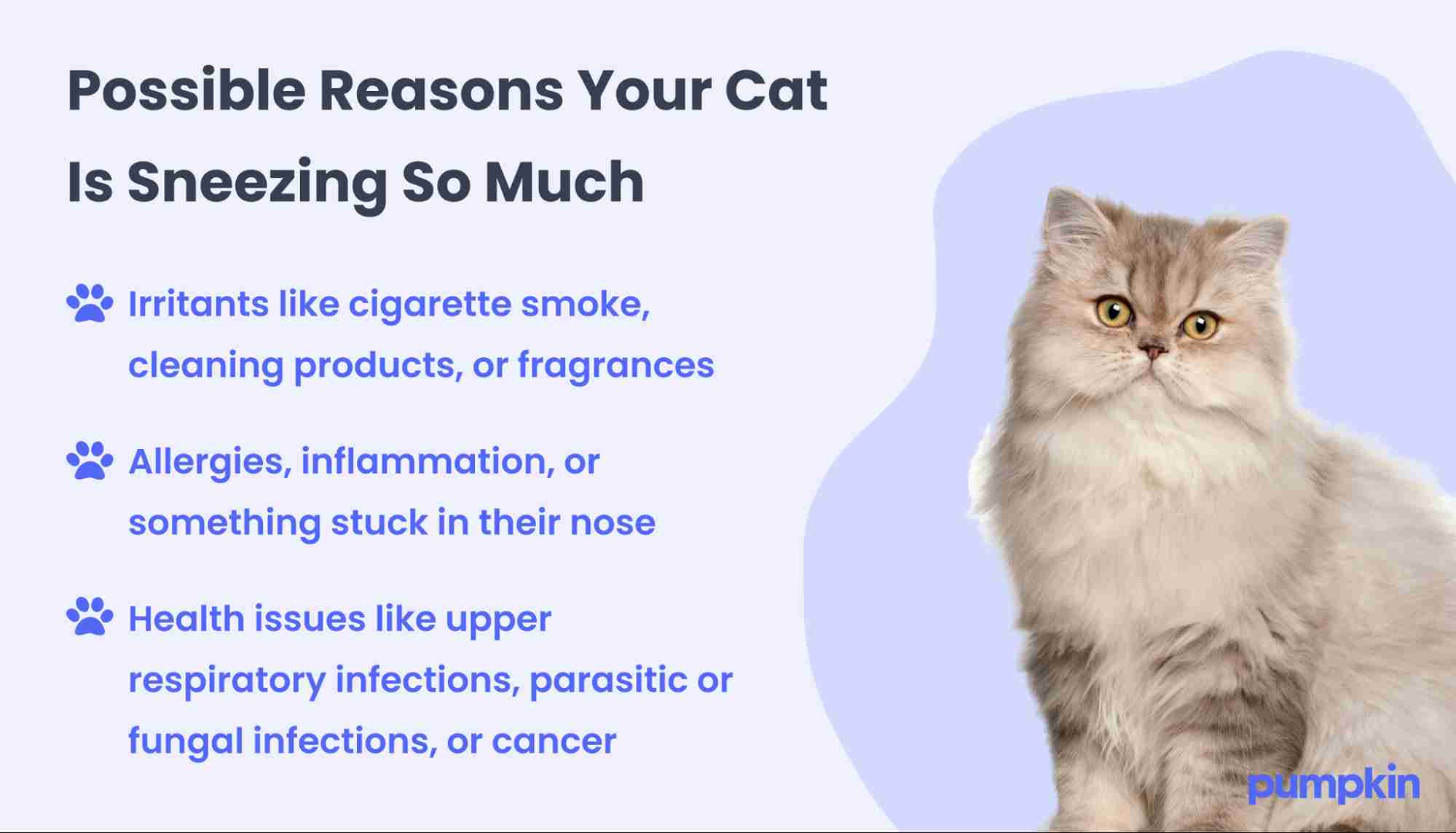
Here’s what you need to know about URIs, or what I call “cat colds.”
What is a feline upper respiratory infection?
Feline upper respiratory infections are a common cause of sneezing, runny eyes, discharge from the nose, and even eye infections in cats. While mild cases only result in the occasional sneeze and extra nap time, others can impact your cat’s immune system. You may notice decreased appetite, lethargy, fever, and changes in behavior like hiding or acting aloof.
A feline URI is similar to the common cold in humans because they’re both caused by a viral infection. Although, unlike humans who catch a cold in the winter months, cat colds can occur year-round.
As a veterinarian, I usually see more sneezing cats in the spring and summer, which likely coincides with “kitten season,” aka when pet overpopulation overwhelms shelters.
What causes feline URIs?
In cats, upper respiratory infections are caused by:
- Feline herpesvirus (FHV-1), a virus
- Feline calicivirus (FCV), a virus
- Bacteria such as Chlamydia and Mycoplasma
- Bordetella bronchiseptica (aka kennel cough)
- And though it’s rare, SARS-CoV-2 (coronavirus)
How do cats get upper respiratory infections?
URIs are transmitted by exposure to certain bodily fluids (such as the saliva and spray of fluid coming out of your cat’s sneeze or runny nose). If your cat has recently stayed in a kennel, they probably caught their URI before you brought them home. These infections can develop just a few days after exposure. Unfortunately, if you have other cats in your household, they could be sneezing soon, too.
Thankfully, URIs aren’t contagious to you, but they can be extremely contagious to other cats. That’s why I’m such an advocate of separating and quarantining a new pet in your household from other pets for at least 5-7 days to be safe.
Pet Pro Tip: As a responsible pet parent, you should seriously consider pet insurance. Properly understanding how pet insurance works and what pet insurance covers can help you make an informed decision about your pet’s health needs and plan your finances accordingly.
It’s also important to know that like a human cold sore on your lip, URI viruses can “hide” in the body for years — especially if your cat has a problem with their immune system. For example, if they’re immunosuppressed from feline immunodeficiency virus (FIV) or if they’re a young kitten.
This means that if your cat caught a cold a decade ago from the shelter when you adopted them, it can “recrudesce” and come back with any stress (just like a human cold sore).
Why is my cat sneezing a lot? Clinical signs of URIs
When your cat starts sneezing excessively, a cold is the likely culprit. The most common signs of a “cat cold” are:
- Frequent sneezing
- Nasal discharge
- Eye discharge
- Loss of appetite
- Lethargy
- Hiding
- Difficulty chewing food
- Drooling (usually secondary to ulcerations in the mouth, e.g., on the tongue or palate)
- Bad breath
- Increased pink coloring or redness to the tissues surrounding the eyes (e.g., conjunctivitis)
- Squinting of the eyes due to corneal ulceration
- Heavy breathing
- Breathing with the mouth open
- Increased respiratory effort
- Loud breathing or snoring sounds
- Fever
How are upper respiratory infections in cats diagnosed?
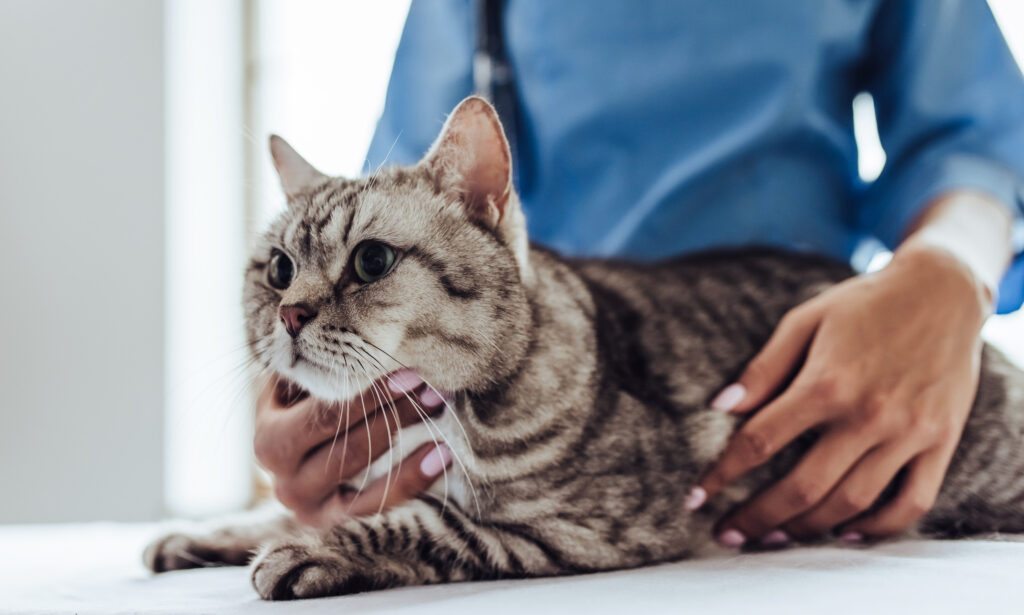
When we veterinarians diagnose a cat with a URI, it’s based on history, clinical signs, physical examination findings, underlying conditions, and response to treatment. That said, your vet may perform further tests to rule out other possible causes of your cat’s symptoms, such as:
- Physical exam: To look for signs of inflammation, redness, tumors, pneumonia, or other respiratory complications.
- Rhinoscopy: Inserting a small camera into the cat’s nasal passages to examine the area for tumors or fungal plaques.
- Blood work: Carried out in really sick cats to rule out low blood sugar, dehydration, anemia, evidence of infection, or feline leukemia/FIV status
- Imaging: To diagnose any underlying causes and determine the extent of damage in the nose.
- Biopsy: Taken from the nasal cavity walls to check for potential causes of chronic sneezing such as inflammation, fungal infections, or cancer.
These additional tests can provide crucial information to help determine the best course of treatment for your beloved pet.
How are upper respiratory infections in cats treated?
Before you do any more frantic Googling, you should know that there’s no cure, antidote, or medication for a feline URI. The best treatment option for a cat cold is really just tender loving care at home. Most of the time, the cold will go away on its own in a week or two.
However, if your cat’s condition worsens, get to a veterinarian as soon as possible. Some cats may need to be hospitalized for more intensive veterinary care.
How do you treat a sneezing cat at home?
So, what does TLC look like for a sick cat? Head scratches are a good place to start, of course. And since you can’t give them chicken noodle soup, you can try these common techniques to keep them comfortable while they get better.
Try a humidifier
If your cat sleeps with you, consider using a humidifier in the bedroom to help hydrate the nasal passages. This will also make it easier to wipe away the nose crusts.
Bring your cat into the bathroom while you shower
When you go to shower, let your cat lounge on the bathroom floor and skip the ceiling fan. The humidified, warm, steamy air can help them breathe better.
Yummy canned cat food, please!
When your cat’s nasal congestion is all discharge or cat boogers, they can’t smell food. And if your cat can’t smell food, they won’t eat it. You’ll need to tempt your cat to eat something super palatable — like extra-stinky canned food.
Also, try hand-feeding your cat, as it may encourage them to eat. Don’t force feed, however; that’s a huge no-no.
Quarantine them
If you have more than one cat, it’s important to keep your sick cat away from their healthy brothers or sisters since URIs are so contagious.
Clean their nose regularly
You can use a damp cloth or cotton wipe to gently remove any discharge from the nose, eyes, and mouth. Cats are obligate nose breathers. In other words, they don’t open their mouth to breathe unless they are really struggling, so keep those nostrils clean and clear!
Skip the lysine
While it’d be nice if lysine helped cats with colds, recent evidence hasn’t found it to benefit cats with URIs. I don’t believe it’s worth pilling your cat over.
What if my cat isn’t getting better?
If your cat still isn’t showing signs of improvement after one to two weeks, get to a veterinarian as soon as you can, as your cat may need additional medication and supportive care.
This includes subcutaneous fluids (given under the skin) to help hydrate your cat, a long-acting antibiotic injection (if there’s evidence of a secondary bacterial infection or pus from the eyes or nose), appetite stimulants (e.g., mirtazapine), or even eye medication (if corneal ulcers or conjunctivitis is present).
In rare cases, an emergency or overnight veterinary visit may be necessary for intravenous (IV) fluids, IV antibiotics, oxygen, supportive care (including nebulization, humidification, and heat support), and a temporary feeding tube in severe cases.
Persistent sneezing in cats can have many causes, most of which are of little concern. Preventative care — like keeping your cat indoors, up-to-date on vaccines, and healthy — is the best way to prevent respiratory conditions like URIs.
About the Author: Dr. Justine Lee, DACVECC, DABT is a board-certified veterinary specialist in emergency care (DACVECC) & toxicology (DABT).
Pet Pro Tip: If you’re worried about expensive veterinary costs from unexpected accidents or illnesses in the future, then consider investing in pet insurance. A Pumpkin Pet Insurance plan can help cover eligible vet bills in the future.
